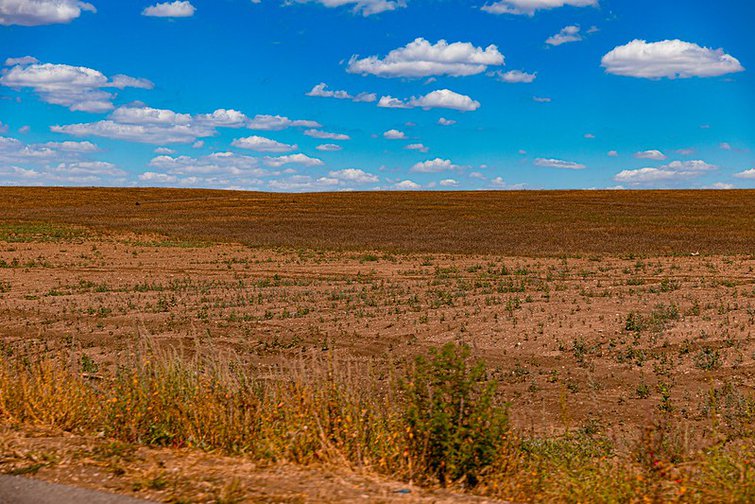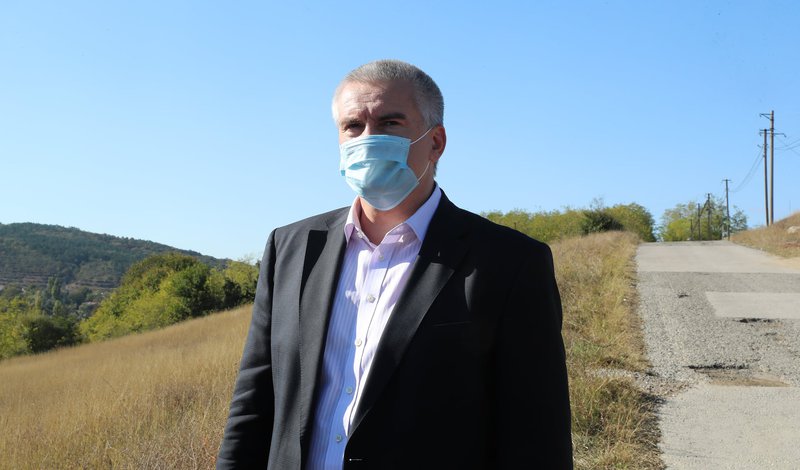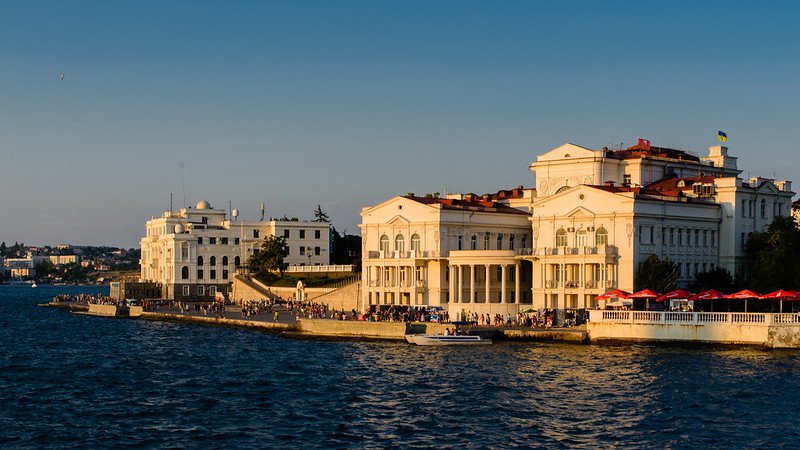Inside Crimea’s slow-burn water crisis
Source :https://www.opendemocracy.net/en/odr/inside-crimeas-slow-burn-water-crisis/Water shortages in the Russian-occupied peninsula are getting worse - and a real solution is not yet in sight.
22 October 2020

Dried-up Crimea
|CC BY 2.0 Dmitry Karyshev / Flickr. Some rights reserved
“We have a large family, three kids, so of course we don’t have enough water,” says Tatyana Mikhalchuk, who lives in Gresovsky, a settlement near Simferopol.
A year ago, Tatyana and her husband Arseny decided to move to the Crimean capital from Armyansk, a town in the north of the peninsula. She says that one of the reasons for their relocation was a fear of being left without any water. Northern Crimea is considered the peninsula’s driest area, so towns like Armyansk would be the first to suffer in case of trouble.
There’s reason to be concerned. Dried-up rivers, decreasing reservoirs and a bad harvest – this is what Crimea has been through in 202,0 the driest year in the last 150, according to local officials. To combat the drought, the Crimean authorities have introduced a water supply timetable in some areas of the peninsula, and are even ready to try cloud seeding to generate artificial precipitation.
The water shortage has knock-on effects. In summer 2018, high temperatures and a lengthy period without rain led to a series of leaks of toxic chemicals, such as sulphurous anhydride, hydrogen chloride, ammonia, at the Crimean Titan water plant. Tatyana’s husband caught pneumonia as a result, and several of his friends were diagnosed with respiratory burns. “When we moved, we believed that the authorities would at least always find a way to provide the capital with water,” Tatyana recalls.
openDemocracy explores how the population of Crimea is dealing with the water crisis and how the local authorities are planning to overcome it.
“A brown liquid instead of water”
“It’s not water that comes out the tap, but some kind of brown liquid,” Tatyana tells me. “Every day I get up at six in the morning and spend thirty minutes running water into the bathtub, so that it is at least a bit transparent, and my husband can take a shower before going to work and I can wash the floors.”
Tatyana says that the acute shortage of water is not the only problem facing Simferopol residents as a result of the drought. Immediately after the shortages started, the quality of water also noticeably deteriorated.
“If the authorities had undertaken extensive repair works of the water supply network over the last six years, it would have been possible to avoid the harsh restrictions now”
Since the end of August, timetables for water supply have been introduced in Simferopol and Bakhchysarai. Authorities restricted water supply in three steps. Currently, private flats and houses in Simferopol receive water for six hours per day (three hours in the morning, and three in the evening). Initially, it was assumed that this would be the strictest possible measure, but officials now state that if levels at water reservoirs do not improve, Simferopol will receive water every other day.
Meanwhile, the authorities have acknowledged the problem of water quality in some districts of Simferopol, and claim it is related to water washing up metal corrosion from the pipes. Indeed, Tatyana and Arseny Mikhalchuk have had to switch off the water filters installed in their flat - a company engineer told them that the filtration system would break in a few days at this level of contamination.
For cooking and washing her two young children, Tatyana has to buy water at special terminals and bring it home in plastic bottles with her car. This water costs three-four roubles (£0.03-0.04) per litre, and her family uses 40 litres per day.

Tatyana says that in theory one can collect water for free: across different districts of Simferopol, special plastic barrels with drinking water have been installed. However, this service is far from perfect: sometimes you have to drive around the city to find water; barrels everywhere are empty.
Before Russia annexed Crimea in 2014, 85% of its water was supplied via a canal that runs from the Ukrainian region of Kherson, directly to the north. Approximately 80% of water was used for agricultural needs, the remaining 20% was channelled to water reservoirs and used to supply the population. In 2014, Ukraine blocked the canal by building a dam, stopping water supplies to the peninsula.
Representatives of the Ukrainian authorities have repeatedly stated that they would not restart the water supply to annexed Crimea. This summer, head of the Ukrainian government Denys Shmyhal said that “restarting water supplies via the North Crimean canal is not on the agenda, and is not the subject of any kind of negotiations.”
How to save Simferopol
Currently, Crimea is home to more than ten natural drainage water reservoirs, with an additional one in Sevastopol - and these reservoirs are the only source of water supplies in the region.
Experts have been calling attention to warning signs of drought since 2018. For example, at a session of Russia’s Federation Council, representatives of Crimean state water company reported that the regular seven-year water cycle was coming to an end and that water levels in local reservoirs would be substantially lower in the near future.
In spring this year, meteorologists noted that an acute shortage of precipitation had been observed in Crimea’s mountains. In comparison to the previous year, their level was lower by 91-96%, while there was no precipitation at all in some mountain river basins.
When the volume of water that flows into Simferopol’s reservoirs started approaching a critically low level, Crimean authorities took measures to sustain the water balance in the capital. For example, they deployed a Russian military pipeline unit to build a 50-kilometre water pipe to connect Simferopol to the Taygan water reservoir, located in nearby Belogorsk.
However, according to locals, this project was marred by accidents. Pipes were built in a rush, and occasionally burst. ‘For hours, all the inhabitants of Belogorsk could observe water fountains stretching 10 metres in the air coming from the pipes,” local businessman Oleg Zubkov says.

In June 2020, Crimean leader Sergey Aksenov stated that the only cloud-seeding plane in Russia would be sent to the peninsula. This plane, when it discovers thunder clouds, can shoot them with silver iodide, causing rain. After Aksenov’s announcement, the state tender portal published a tender for “experimental works”. Crimea’s Central Aerology Observatory, a federal budget organisation, won the 25.5 million rouble (£252,000) contract from the local budget. openDemocracy was unable to establish whether the organisation has begun work, and when the contract is supposed to be completed.
Civic activist Oleg Kocherov claims that the current drought has shown how negligent the local authorities are. According to him, Simferopol’s water network has degraded to 60-70% of its original function. Therefore, most of the drinking water that is pumped out of the reservoirs does not reach consumers, instead disappearing into the soil.
“If the authorities had undertaken extensive repair works of the water supply network over the last six years, it would have been possible to avoid the harsh restrictions now,” Kocherov adds.
Dried-up wells and rivers
The current drought has not only affected Crimea’s urban population. Countryside dwellers in settlements that still lack centralised water supply have also experienced water deficit due to a sharp drop in river levels and underground water sources.
An inhabitant of Golubinka village, Varvara Vasilyeva, complains that “there is no harvest this year. There is no harvest because we stopped watering in summer. There was no water.”
Golubinka is situated on Crimea’s Belbek plain, to the south-west of Bakhchysarai. Many settlements in this area do not have centralised water supply. Moreover, it is impossible to drill water wells at many plots due to the landscape. As a result, many villagers have to use water from communal wells.
Vasilyeva says that it became obvious during the summer that the water pressure in her well was getting weaker and weaker - until one day there was no water in the hose.
She adds: “Well pumps cannot run without water. We turned the pump on a few times, but there was no water, the level was too low. So we decided not to risk it and simply left our plot without water.”
Moreover, this autumn residents of Bakhchysarai district had to struggle to protect a local river that flows through the plain: the authorities in Sevastopol were planning to build a water supply system over the Kokkozka river. This new installation was supposed to collect fresh water and channel it to the Chernorechensk water reservoir, which is the only reservoir supplying the city with half a million inhabitants.
The protest of the local people was heard, and the project was cancelled. The level of water in the river remains extremely low.
“We were trying to escape a drought, but it has caught up with us here. How long will we be able to tolerate all of this? And what can we do when we cannot tolerate this anymore?”
Ecologist Margarita Litvinenko says that the mass drying up of Crimean rivers is one of the most dangerous phenomena caused by the current drought. At the moment, several rivers have already dried up, including the peninsula’s largest river, the Belbek.
Some rivers have dried up due to natural causes. Others, for example, the Biyuk-Karasu river in Belogorsk district, due to the intervention of military units who built a dam. The resulting reservoir is also used for suppling water to Simferopol, according to Ilya Bolshedvorov, an inhabitant of the district who witnessed the works.
He adds that as a result several villages, located downstream, have been deprived of water, while some endangered species of local flora and fauna are doomed to extinction.

In comparison to other districts of Crimea, the situation with water supply in Sevastopol currently looks more stable. At the beginning of October, the volume of water in the city’s Chernorechensk reservoir was 18,000,000 cubic metres (maximum volume: 67,000,000 cubic metres).
On average, the city consumes around 170,000 cubic metres of water per day - according to official estimates, there is enough water to last until December.
This month, city officials began to take measures to save water, but the only people who have experienced water problems are members of gardening cooperatives, or small cottage settlements. These districts have not shifted their water supply regimes (there are two regimes - winter and summer), and therefore cooperatives which do not have their own wells receive water with weaker pressure.
Moscow’s interventions
From the moment when the North Crimean water canal was blocked, Moscow has been working on several solutions to Crimea’s water shortages. However, none of these projects has been realised in practice: a project of a water pipeline that would supply water to Crimea from Krasnodar has been deemed impractical; building desalination stations is considered too expensive and not profitable.
Moscow’s search for “complex solutions” thus continues. In September, Russian deputy prime minister Marat Khusnullin reported that he had instructed the Ministry of Nature and Rosgeology, the state geological exploration company, to work out a “project of supplying the whole region, and especially Simferopol and Sevastopol, with water”.
Schvabe, a company owned by the state Rostech corporation, recently attempted to resurrect a project of desalinating water in Crimea. Company representatives stated that they are ready to set up the first Russian-made desalination station outside Simferopol.
Russian president Vladimir Putin does not often comment on water shortages in Crimea. At the opening of a new motorway, he merely mentioned that the issue “is still to be resolved”.

“Sometimes it seems to me that this whole story is a strange and unjust dream,” Tatyana Mikhalchuk says. “We were trying to escape a drought, but it has caught up with us here. How long will we be able to tolerate all of this? And what can we do when we cannot tolerate this anymore? I am trying not to think about this yet.”
According to specialists, there are few reasons for optimism. More and more districts in the peninsula are introducing water supply restrictions: in September, the city authorities of Alushta decided to lower pressure in their water supply networks.
The head of Crimea’s Council of Ministers Yuri Gotsanyuk predicts that water restrictions will have to continue until March 2021.



















































Yorumlarınızı Bizimle Paylaşın
Sadece üyelerimiz yorum yapabilir, hemen ücretsiz üye olmak için Tıklayın